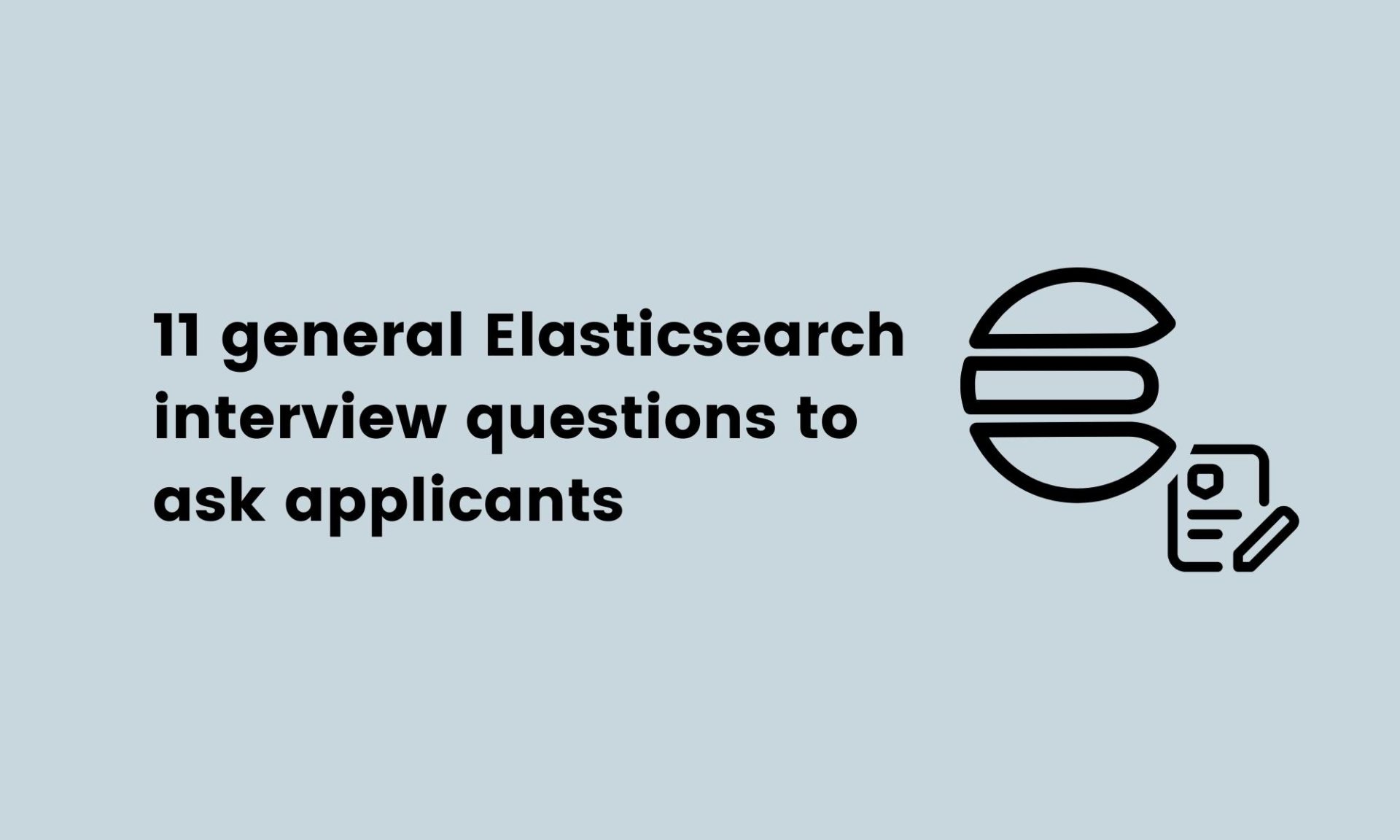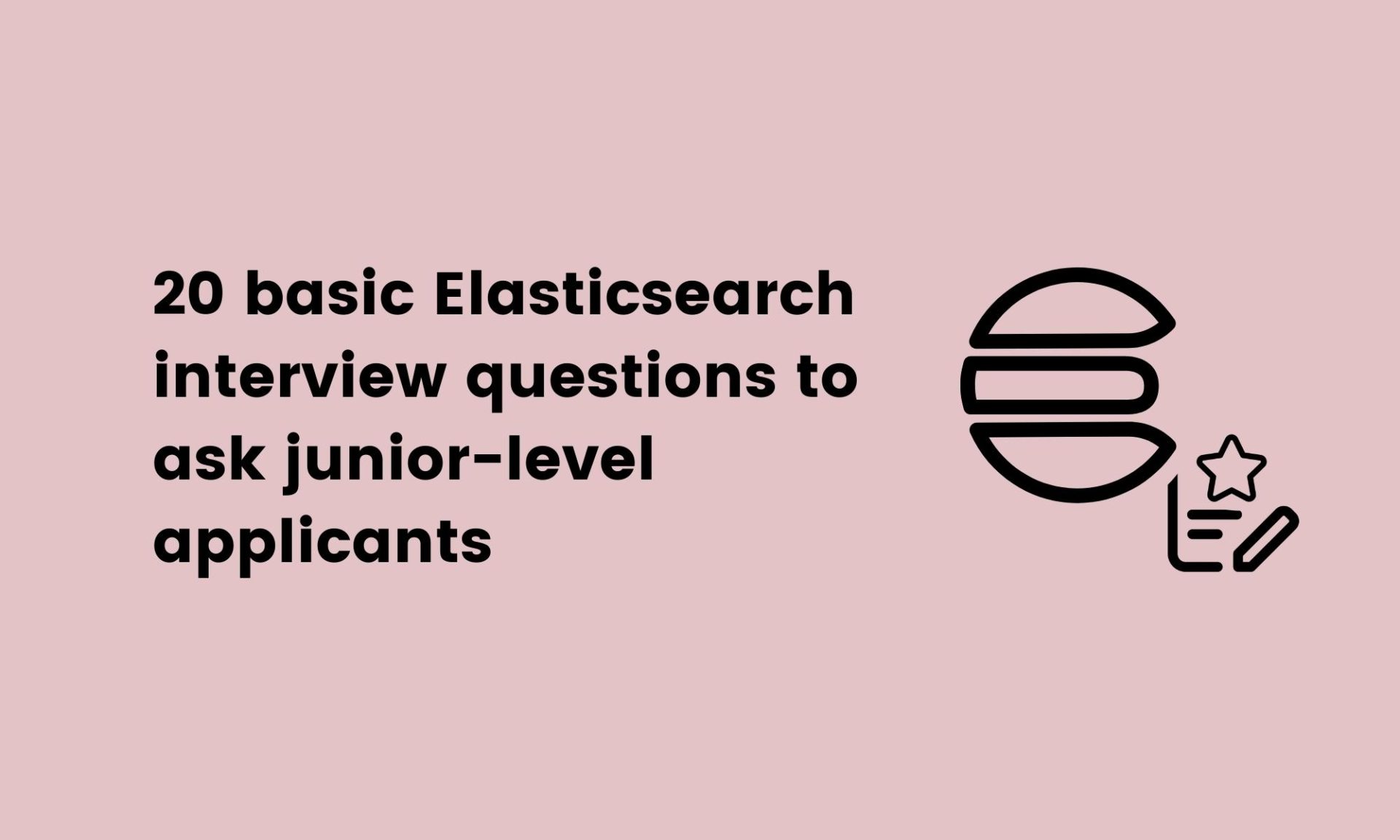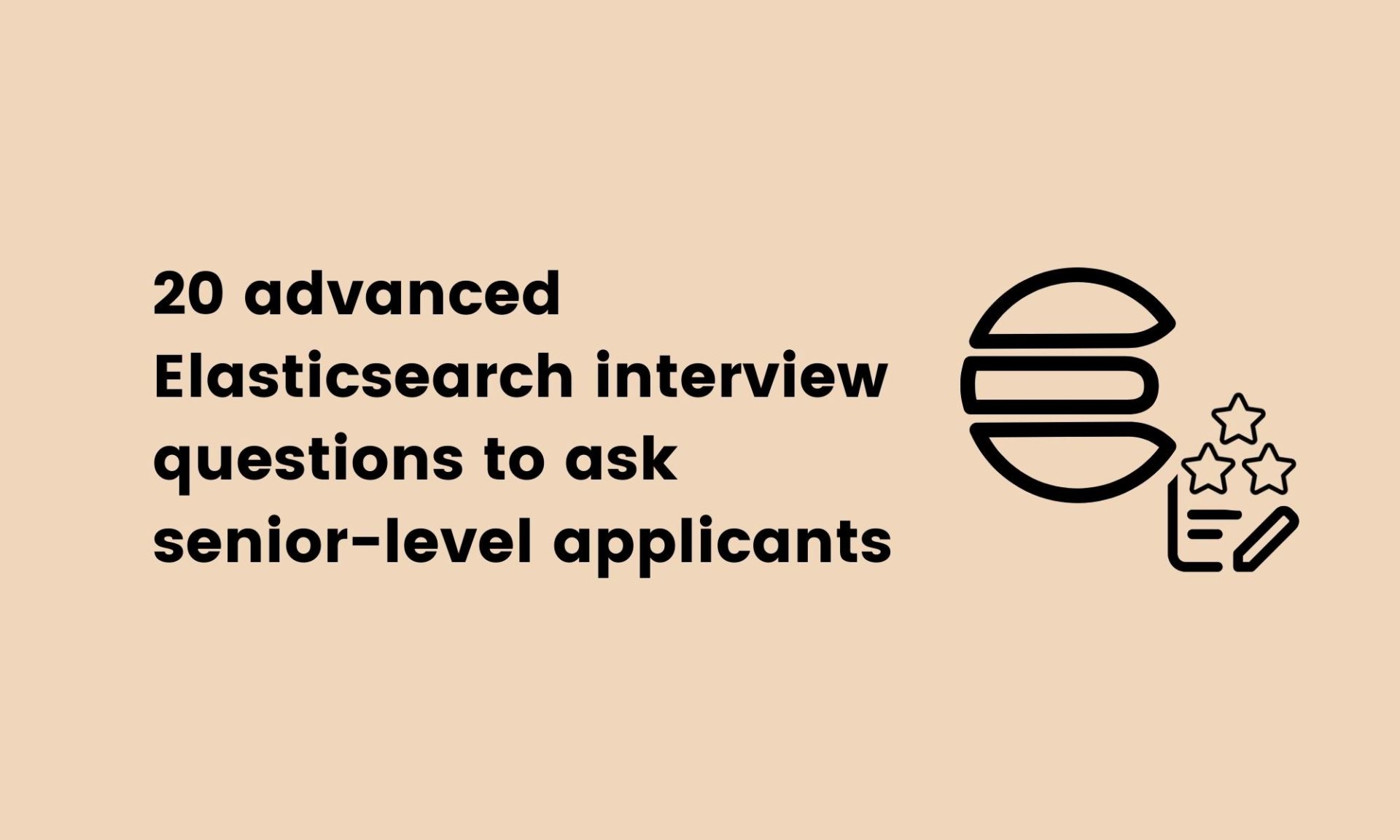So, you’ve done the difficult part and written a job description that best describes the Elasticsearch engineer role you’re hiring for.
What’s next? As you source software engineers, you’ll need a way to evaluate them.
You can begin this process with a skill testing method, using an Elasticsearch test which is easy to incorporate after the candidate sourcing stage.
You can also conduct interviews to gain a deeper understanding of applicants’ qualities and qualifications, but for that, you’ll need the right questions.
If you’re looking for the best Elasticsearch interview questions to use, you’ve come to the right place. This article has all the questions you need to interview your candidates.
Table of contents
- 11 general Elasticsearch interview questions to ask applicants
- 5 general Elasticsearch interview questions and answers to review candidates’ responses
- 20 basic Elasticsearch interview questions to ask junior-level applicants
- 5 basic Elasticsearch interview questions and answers to gauge applicants’ responses
- 20 advanced Elasticsearch interview questions to ask senior-level applicants
- 5 advanced Elasticsearch interview questions and answers to assess interviewees
- 5 tips for integrating Elasticsearch interview questions and skill tests into your recruitment process
- Hire top Elasticsearch engineers with the right Elasticsearch interview questions
11 general Elasticsearch interview questions to ask applicants
Here are 11 Elasticsearch interview questions to ask new talent. These will enable you to gather all the information you need to assess your applicants’ general understanding of Elasticsearch.
Explain what Elasticsearch is.
Explain what a cluster is.
Explain what an ELK stack is.
Explain what indexing means in Elasticsearch.
Name three critical Elasticsearch features.
Name three advantages of using Elasticsearch.
How would you search in Elasticsearch?
Which technical skills do ELK stack and software engineers need to use Elasticsearch?
Which soft skills do ELK stack and software engineers need to use Elasticsearch?
Name three organizations that use Elasticsearch with their search engine and application database.
5 general Elasticsearch interview questions and answers to review candidates’ responses
Use the sample answers to five of the general Elasticsearch interview questions to review your ELK and software engineers’ responses.
1. Which soft skills do ELK stack and software engineers need to use Elasticsearch?
Can your applicants give examples of some soft skills vital for software engineer roles?
Do they know that to use Elasticsearch successfully, engineers need the right mix of motivation, analytical skills, problem-solving abilities, and interpersonal skills? Are they aware that a customer-oriented approach can also help new software engineers succeed?
2. How would you search in Elasticsearch?
Applicants should know a few of the main methods for searching in Elasticsearch. Examples include:
Request body search, where an engineer completes a search request and executes it with search DSL
Uniform Resource Identifier search, where an engineer can use a URI with which they provide the requested parameters
Multi-index search, where an engineer can search different APIs that apply for various indices via multi-index systems
3. Explain what an ELK stack is.
The ELK stack refers to a group of three essential open-source tools. Can your applicants name them? Candidates should know that these tools include Elasticsearch, LogStash, and Kibana, which are used for log storing, log shipping and processing, and visualization.
4. Name three critical Elasticsearch features.
Three critical Elasticsearch features your engineers may list when answering this question include:
A REST API interface and JSON output
A replicated searchable document store
Multi-language support
5. Which technical skills do ELK stack and software engineers need to use Elasticsearch?
Some handy technical skills ELK stack and software engineers may require to use Elastic search include DevOps skills (that you can assess with a DevOps test) and data storage.
Applicants may also mention that index mapping is important, as is data retrieval when using Elasticsearch.
The best insights on HR and recruitment, delivered to your inbox.
Biweekly updates. No spam. Unsubscribe any time.
20 basic Elasticsearch interview questions to ask junior-level applicants
Here are 20 basic Elasticsearch interview questions to ask potential new hires. Use these to evaluate your applicants’ junior-level skills.
Describe the architecture of the ELK stack.
Name four vital operations ELK and software engineers can perform on a document.
Which method would you use to delete indexes in Elasticsearch?
Which method would you use to add mapping to an index?
What does the multi-index or multitype search option do in Elasticsearch?
What does the URI search option do in Elasticsearch?
What does the request body search require in Elasticsearch?
Name three configuration management tools that Elasticsearch supports.
Explain what Apache Lucene is.
Explain what NRT means in Elasticsearch.
Which main Elasticsearch cat API commands can ELK and software engineers use?
What does ingest node do?
Explain what the fuzzy query does in Elasticsearch.
Explain what dynamic mapping does in Elasticsearch.
Explain what the graph explore API does in Elasticsearch.
Which software do ELK and software engineers need to install Elasticsearch?
How would you initiate an Elasticsearch server?
Explain what shards are in Elasticsearch.
Describe or write down the syntax required to add mapping to an index.
Explain what a node is in Elasticsearch.
Which Elasticsearch abilities are you working on at the moment?
5 basic Elasticsearch interview questions and answers to gauge applicants’ responses
Check these five basic Elasticsearch interview questions and our sample responses to them. Use them to review your software engineers’ answers.
1. How would you initiate an Elasticsearch server?
Are your applicants aware that to initiate an Elasticsearch server, engineers must complete three critical steps?
Your candidates should be able to outline the following steps when responding to this Elasticsearch interview question:
Begin by opening the command prompt via the start menu in Windows
Use ./bin/elasticsearch in the command line to change the directory
Use /Elasticsearch.bat and start the Elasticsearch server by pressing enter
2. Explain what shards are in Elasticsearch.
Applicants should be aware that shards are small chunks of indexed data created due to an increased number of documents and lower processing power.
3. Explain what the graph explore API does in Elasticsearch.
Can your applicants explain that the graph explore API helps engineers extract and summarize data corresponding to documents in the Elasticsearch index? Do they know that the graph UI helps engineers understand the explore API?
4. Explain what dynamic mapping does in Elasticsearch.
Skilled interviewees should know that dynamic mapping involves automatically detecting and adding new fields. Can they also explain that customization of dynamic mapping rules is possible if engineers need to match them to a particular requirement?
5. Which Elasticsearch abilities are you working on at the moment?
Candidates may be working on their soft skills, such as communication or time-management skills, which you can assess with a Communication test or a Time-management assessment. They may be working on their DevOps or data analysis skills.
Look for applicants who know the importance of refining their skills continuously.
20 advanced Elasticsearch interview questions to ask senior-level applicants
Here are 20 advanced Elasticsearch interview questions to ask skilled ELK stack engineers with senior-level experience and determine if your advanced applicants are a good fit for your open role.
How would you retrieve a document using IDs in Elasticsearch?
What is a text query?
What is a term query?
How are text queries different from term queries?
Explain what aggregation is in Elasticsearch.
Explain how the master note is different from master eligible nodes.
What are the main X-Pack commands?
Which use cases are related to the ELK log analytics?
What does Elastic stack reporting do?
How would you use Beats with Elasticsearch, and what does it do?
Explain what the CAT API does in Elasticsearch.
Explain why X-Pack is important to install with Elasticsearch?
Explain whether Elasticsearch has schemas.
Explain what replicas are in Elasticsearch.
Explain what an analyzer is in Elasticsearch.
Name four types of analyzers in Elasticsearch.
Explain what tokenizers are in Elasticsearch.
Explain what filters are in Elasticsearch.
What is the leaf query type of clause?
What is the compound query type of clause?
5 advanced Elasticsearch interview questions and answers to assess interviewees
Use the answers below to five of the advanced Elasticsearch interview questions to simplify reviewing your applicants’ responses.
1. What are the main X-Pack commands?
Are your applicants aware of the main X-Pack commands?
Candidates with advanced Elasticsearch knowledge should be able to list the following commands when responding to this Elasticsearch interview question:
Setup-passwords
Syskeygen
Users
Migrate
Certgen
2. Explain what an analyzer is in Elasticsearch.
Can the applicants for your senior role explain that an analyzer transforms data internally when defined for the index? Can they explain that analyzers are made of filters and tokenizers?
3. Name four types of analyzers in Elasticsearch.
Knowledgeable applicants should be confident when listing types of analyzers in Elasticsearch. Can they list four examples? Some of the main types they may list include:
WhiteSpace analyzer
Keyword analyzer
Language analyzer
Custom analyzer
4. Explain what tokenizers are in Elasticsearch.
Can applicants explain that tokenizers break down document values into a stream? Can they explain that engineers make inverted indexes and update them using the values the tokenizers have created as part of the process?
5. Explain what filters are in Elasticsearch.
Can your interviewees explain that they can use filters in Elasticsearch to match certain criteria for documents, which require less time to execute since they are cacheable?
5 tips for integrating Elasticsearch interview questions and skill tests into your recruitment process
Before you begin interviewing applicants for your open role, consider these five tips to seamlessly integrate into your hiring process skills tests and the Elasticsearch questions from this article.
1. Build and administer an Elasticsearch skills assessment after candidate sourcing
The best way to assess applicants’ skills, see if they meet the requirements for your role, and shortlist your best talent for an interview is to use a reliable skill testing platform like TestGorilla.
Begin by building a well-rounded skills assessment of up to five skills tests and make sure to include an Elasticsearch test. The best time to administer skills tests is after applicant sourcing and before interviews.
Skill assessments can also be used to entirely replace resume screening, which is an outdated, slow, and biased approach to candidate selection. Save time and effort by implementing skills tests at the earliest possible stage of recruitment.
2. Use skill test results to create unique Elasticsearch interview questions
If you still need more questions for your interview, one handy tip is to check candidates’ test results and create unique Elasticsearch questions based on the responses.
For example, if you notice that some applicants don’t know what tokenizers are in Elasticsearch, include a related interview question to ask them during the interview. This method will help you better evaluate the depth of your applicants’ knowledge.
3. Use structured interviews
We strongly recommend using structured interviews and note-taking when looking to hire new talent. This approach helps eliminate bias and enables you to compare all applicants’ responses easily.
To use structured interviewing (which is also what Google’s hiring teams do), use the same Elasticsearch interview questions for all applicants in the same or similar order. You can still go off script and ask engineers follow-up questions if needed, but reduce small talk to a minimum.
4. Take note of any impressive feats or red flags
When taking notes, make sure you include information on any exceptional achievements your applicants have accomplished. Likewise, note down any red flags that indicate an applicant may not be the best fit.
For instance, if someone only has limited experience with Elasticsearch but has in-depth knowledge of the search engine and its features and has obtained a good test score, chances are that this candidate is very motivated and a fast learner. Or on the other hand, if they have years of experience but fail to answer some of the more basic questions, consider this a red flag.
5. Review all the data you have on your applicants and make a hiring decision
Once you’ve completed the skills assessment and interview stages, all that’s left to do is to review the data you’ve collected on each applicant in collaboration with your hiring team. Look at the skill-test and interview results to make a hiring decision.
You can then create a tailored onboarding checklist based on your new hire’s specific skills and knowledge.
Hire top Elasticsearch engineers with the right Elasticsearch interview questions
Hiring software engineers for your organization isn’t always easy, but if you combine the two methods outlined in this article – skill testing with an Elasticsearch skill test and using the right interview questions – this will simplify the hiring process significantly.
If you’re still building your list of Elasticsearch interview questions, use the ones listed in this article for the best results. Don’t forget to use follow-up questions as necessary to make sure the interview runs smoothly.
Hire the best Elasticsearch engineers with our Elasticsearch interview questions and skill tests.
Sign up for TestGorilla to access the Elasticsearch skill test and hundreds of other expert-developed pre-employment tests.
You've scrolled this far
Why not try TestGorilla for free, and see what happens when you put skills first.


















